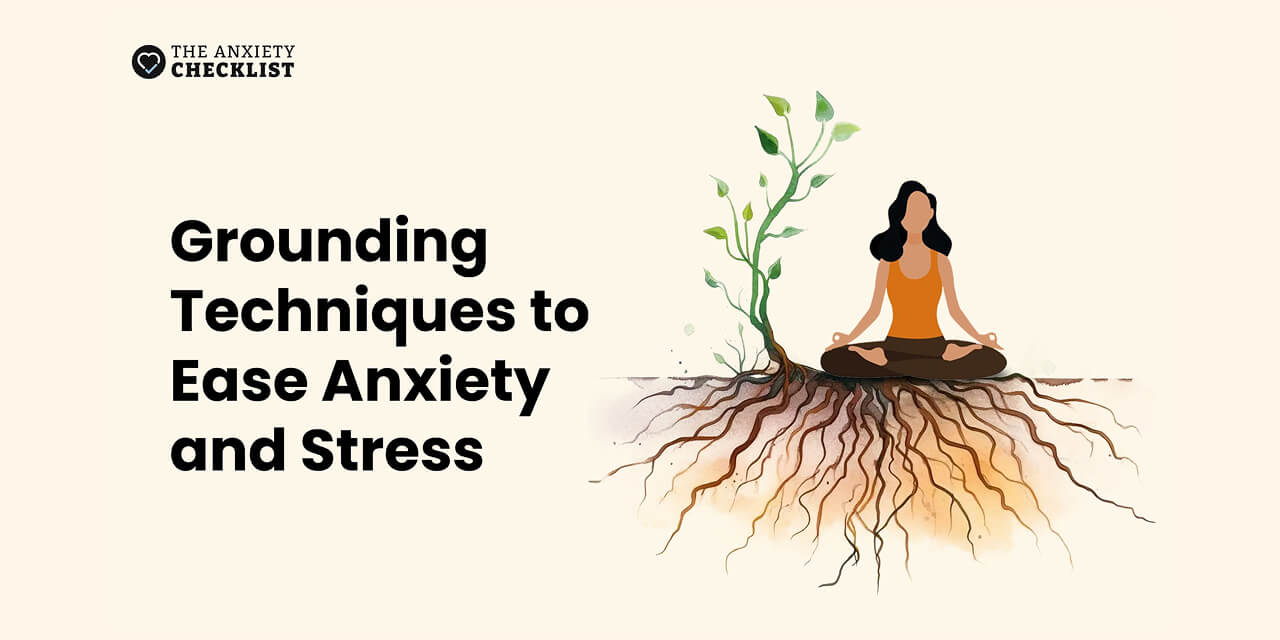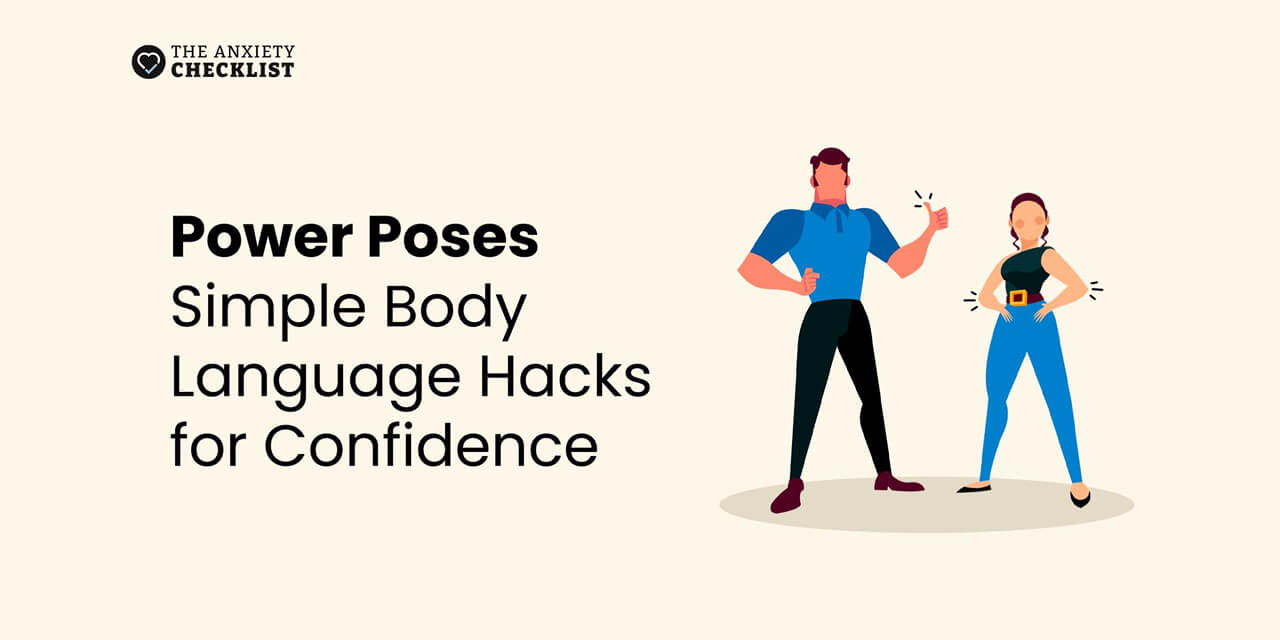When Should You Use Grounding Techniques?
There is no specific time for experiencing anxiety. You can feel the trigger in a crowded space, in a park while walking, or at home while cooking. That’s why these grounding techniques are helpful in managing anxiety in many everyday situations.
Here are some common scenarios where grounding techniques can help:
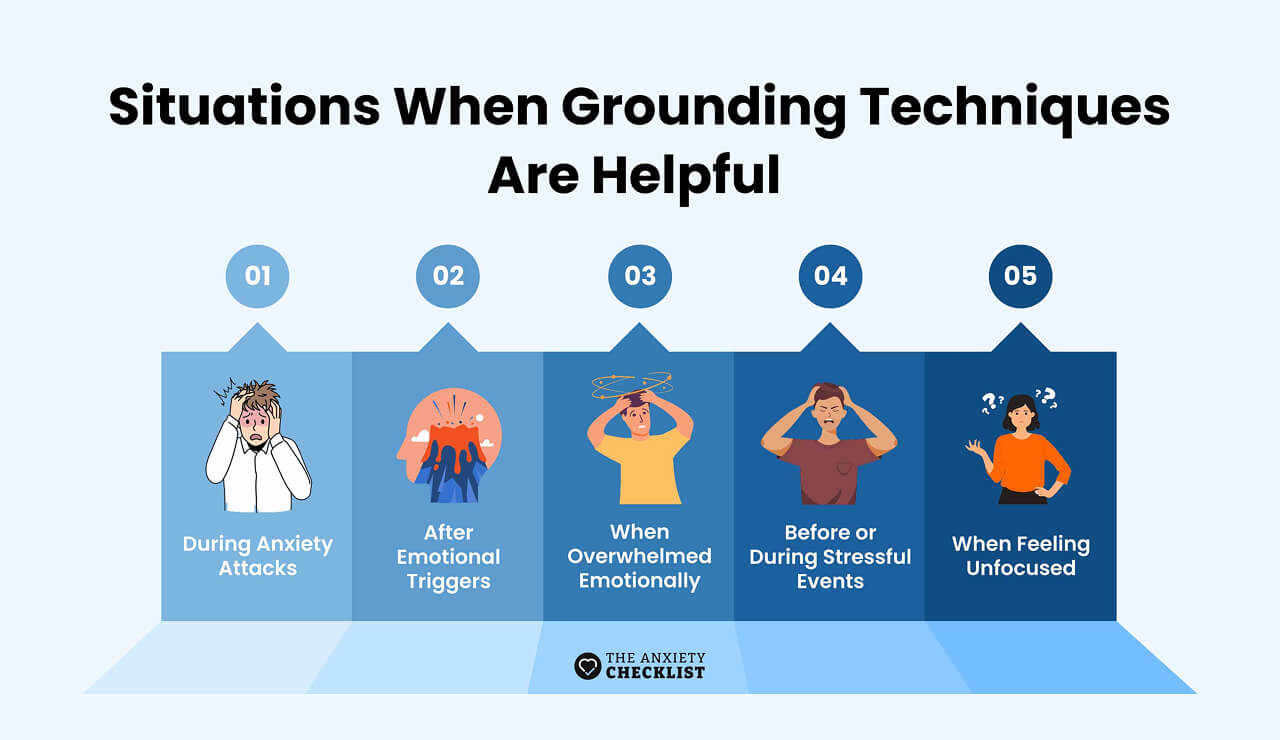
Is anxiety holding you back from the life you deserve?
Practical Grounding Techniques to Stay Calm and in Control
Grounding techniques come in many forms, and they’re most effective when tailored to your preferences and needs. To help you find what works best, we’ve grouped them into four major categories.
Mental/Cognitive Grounding Techniques
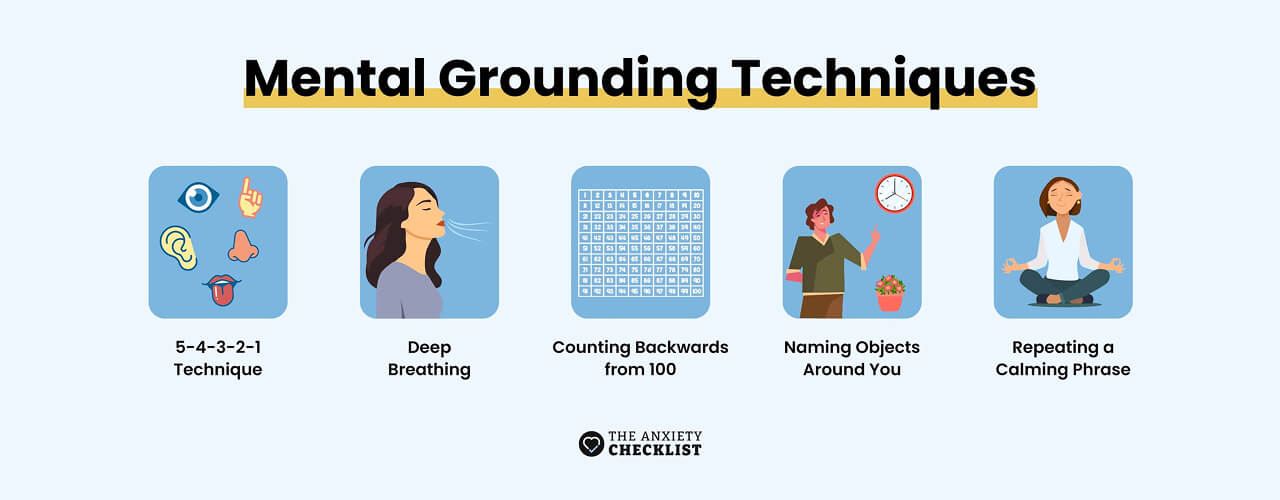
1. 5-4-3-2-1 Technique
This technique works by engaging all five senses. Start by naming five things you can see, four things you can touch, three things you can hear, two things you can smell, and one thing you can taste.
This grounding technique shifts your focus from anxious thoughts to your body and the space around you. Actively engaging your senses helps your mind slow down and become more present. Whether done silently or aloud, take your time with each sense to fully notice and immerse yourself in the experience.
You can use this technique during flashbacks and when you’re overthinking or experiencing moments of high stress. These grounding techniques guide your awareness outward and help you feel more in control.
2. Deep Breathing
Deep breathing is one of the simplest grounding techniques that can help anyone who experiences the fear of being alone or other phobias. It helps regulate your nervous system by slowing your heart rate and calming your mind.
This technique focuses on controlled, slow breaths to interrupt the body's stress response. You don’t need any tools—just a few moments of quiet.
How does it work?
Inhale slowly through your nose for four seconds, hold that breath for another four, then exhale through your mouth for four.
As you breathe, place your hand on your stomach and feel it rise and fall. This makes the process more physical and grounding. You might also want to close your eyes to shut out distractions.
3. Counting Backwards from 100
If you’re trying to shift your focus from anxious thoughts to calmness, counting backwards from 100 is one of the simplest grounding techniques you can use. Start at 100 and count slowly down to 1. Say each number out loud, or silently if you’re in a public space.
If 100 feels too far, start from a smaller number like 50 or 25. If you lose track, simply begin again. You can even add a twist by counting down by threes or sevens to challenge your brain a bit more.
Like many grounding techniques, this method works well because it takes just enough concentration to redirect your thoughts. Each number keeps you engaged in the moment, allowing anxious or intrusive thoughts to drift away.
Counting backwards also works before bed if your mind is racing and you’re having trouble sleeping. It gives your thoughts a path to follow, rather than letting them scatter in every direction
4. Naming Objects Around You
This is one of the grounding techniques that can help with social anxiety disorders. It helps reconnect you to reality by identifying things in your environment.
Look around and name things you see. Start with large objects, like a chair, table, or wall. Then shift to smaller items, like a cup, a pen, or a book.
You can also describe each object briefly. For example, say, “Red coffee mug” or “Wooden desk with scratches.” This sense of focus deepens your awareness and brings your senses to the present moment.
5. Repeating a Calming Phrase
This grounding technique uses the power of words to calm the mind. It involves choosing a short, reassuring mental health quote or sentence and saying it slowly and repeatedly.
It could be something like “I am safe,” “This will pass,” or “I can handle this.” Choose a phrase that feels true and comforting to you. Say it in your head or out loud, then repeat it until your breathing slows and your thoughts settle.
This method is effective because it speaks directly to the brain’s need for reassurance and stability. When emotions are high, logical thinking can fade. A calming phrase brings in a simple message your brain can latch onto. Over time, your body may associate the phrase with a sense of safety and calm.
The beauty of this technique is its flexibility because you can change the phrase to fit what you need at any moment. Some people find writing and breathing exercises to be helpful.
Physical Grounding Techniques
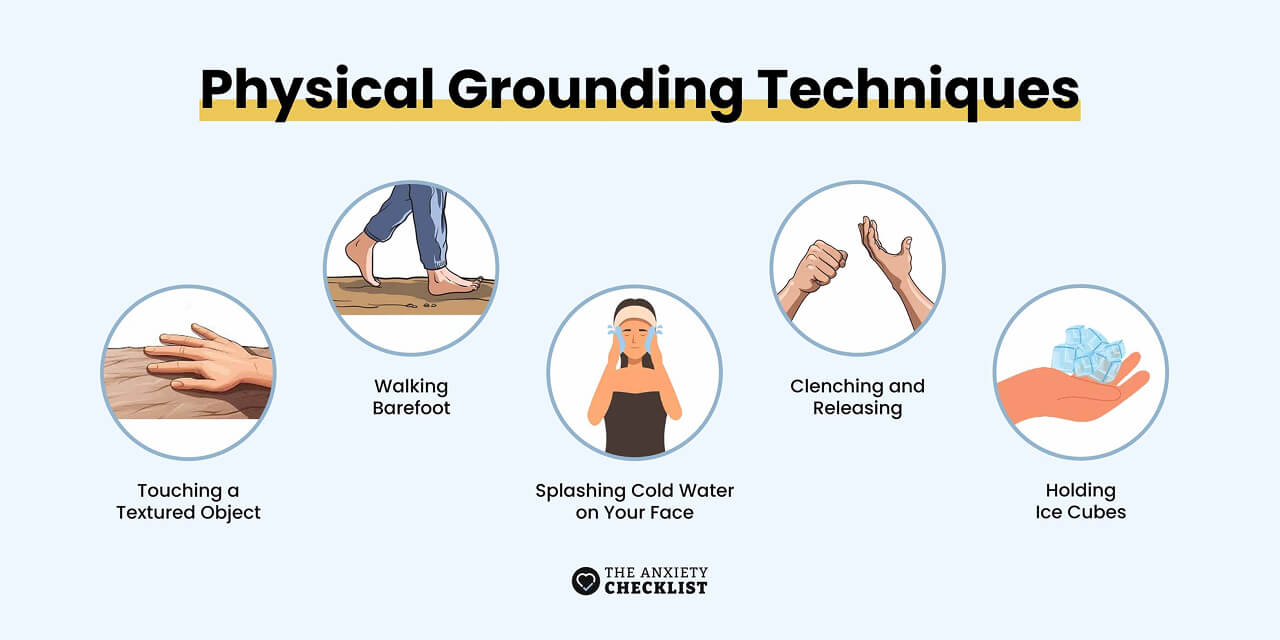
6. Touching a Textured Object
Grounding techniques are all about redirecting focus, and touch is a powerful sense. This is one of the simplest physical grounding techniques that uses physical sensation and sense of touch to anchor your thoughts.
The goal is to feel an object's texture and concentrate on how it feels. You might reach for something nearby, like a rough rock, sandpaper, or a soft fabric. Notice the temperature, the edges, and the weight, then describe these qualities out loud or in your mind.
When you focus on the details of the texture, your brain shifts attention away from worry. Practicing this regularly helps you become more mindful. Try switching up the textures to keep the experience fresh. You can always keep a small collection of textured items in your bag or pocket for easy access.
7. Walking Barefoot
One of the classic examples of physical grounding techniques is walking barefoot. It reconnects you to the earth and helps you feel stable.
This technique is quite simple — take time to feel every step. All you have to do is walk barefoot on the grass, sand, or a smooth floor. Go outside and stroll while focusing on how the surface feels under your feet. Notice the pressure, the temperature, and the texture.
If you're indoors, try walking barefoot on different surfaces. Carpet, wood, or tile can each provide unique sensations. The key is to slow down and notice every detail. It will help slow your mind and encourage mindfulness through movement. When your feet feel the earth, it often has a calming and steadying effect. It reminds your brain that you’re supported.
Try walking slowly and with intention. Breathe deeply as you walk and keep your attention on each step.
8. Splashing Cold Water on Your Face
Another example of stimulating grounding techniques to quickly reset your nervous system is splashing cold water on your face. The cold water snaps your focus back to the moment. It helps cut through anxiety or panic by interrupting your thought patterns. It also stimulates the vagus nerve, which is key in calming the body's stress response.
To try this technique, splash cold water on your face several times. You can do this in a bathroom sink, kitchen sink, or even with a damp cloth. Let the cold water stay on your skin for a few seconds before patting it dry. The goal is to let your body feel the temperature shift and reconnect with the present.
This method can become part of a larger routine of grounding techniques. After splashing water on your face, take a few deep breaths and check in with your body.
9. Clenching and Releasing
The clench and release method is part of the simple physical grounding techniques that help relieve tension.
Start by tensing one group of muscles, like your fists, for five seconds. Then slowly release the tension while focusing on how the muscles feel as they relax.
Continue this process for different muscle groups, like your shoulders, legs, or jaw. The repetition gives your body and mind a rhythm to follow. As your muscles relax, your mind follows, creating a sense of calm and control.
This is one of the grounding techniques often used in therapy as part of progressive muscle relaxation. You may not notice how tense your body is when you're stressed. Grounding techniques like this bring awareness to your physical state and help release built-up stress.
10. Holding Ice Cubes
This is among the physical grounding techniques that can quickly snap your attention back to the present moment. Cold sensation naturally boosts alertness and is impossible to ignore, which makes it a great way to disrupt anxious or racing thoughts.
So, how does this technique work? Grab one or two ice cubes and hold them in your hands for a few seconds. Focus on the feeling, how cold it is, how it melts, and how your skin reacts.
This method can be particularly useful during anxiety attacks. Your mind is drawn to the physical discomfort from the ice cubes, which helps break the emotional cycle.
Emotional/Soothing Grounding Techniques
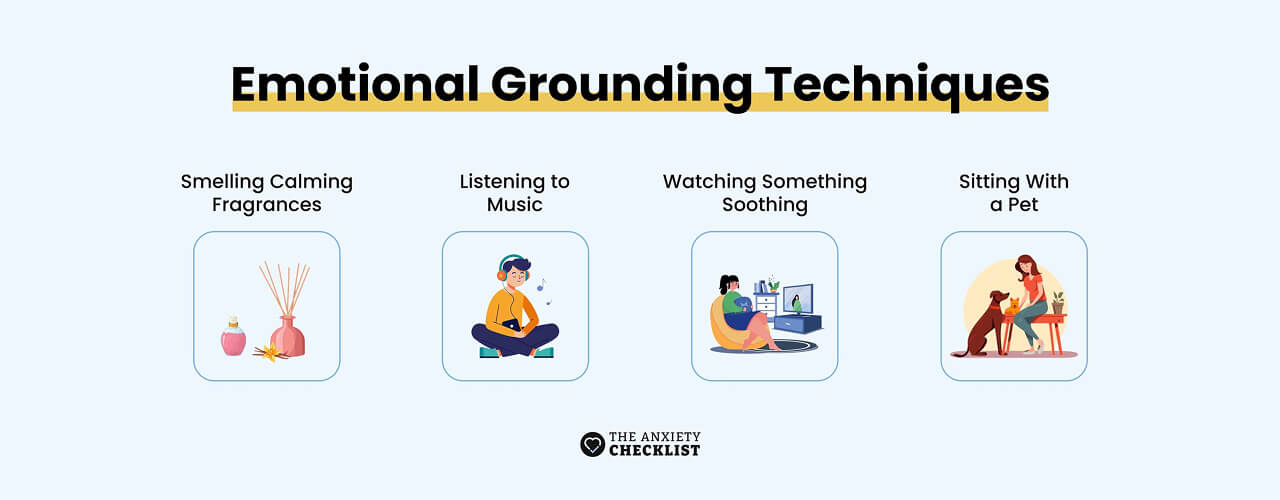
11. Smelling Calming Fragrances
Engaging your sense of smell is one of the most soothing grounding techniques. Scents have a powerful link to memory and emotion, making them an excellent anchor to the present.
You can use essential oils, perfumes, candles, or even a slice of orange. The key is to focus on the scent and let it ground you.
What you need to do is to inhale deeply and notice the different layers of the fragrance. Is it sweet, spicy, earthy, or floral? Describe the scent to yourself in detail.
Smelling something familiar can trigger a sense of safety and comfort. It’s one of the easiest grounding techniques to do in public.
12. Listening to Music
Music has a profound emotional impact. It often connects with our inner mind deeper than words. That’s what makes it one of the most soothing grounding techniques.
It helps with driving anxiety and drowns out external stressors. To use music as a grounding technique, choose songs that make you feel happy or calm. It’s best to have a playlist with songs that evoke positive memories.
You might prefer slow, soothing music or upbeat tracks that spur your energy. As you listen, pay attention to how your body reacts.
Reactions like smiling or crying are signs that the music is helping ground you. The beauty of this technique is its flexibility—you can practice it anywhere, whether you're wearing headphones, sitting in the car, or relaxing at home.
13. Watching Something Soothing
Among the grounding techniques available, this method uses the sense of sight to calm the mind and reconnect with the present. Anything visually gentle and peaceful can act as subliminals for anxiety to help reset your nervous system.
Choose something that slows your mind rather than overstimulates it. A video of ocean waves, falling rain, or a fireplace crackling can be helpful. You can also light a candle and watch the flame flicker gently. The goal is to focus on the movement, color, and light. Let your eyes follow the details without judgment or thought.
Many grounding techniques work better when you engage multiple senses at once. So as you watch, practice mindful breathing. Let your breath mirror the rhythm of what you see — slow, smooth, steady. This will help bring your whole body into the experience.
14. Sitting With a Pet
Spending time with a pet is one of the most comforting and emotionally grounding experiences. Animals offer unconditional love, and being near them can help regulate your emotions and bring you back to the present.
To use this as a grounding technique, sit with your pet and observe their behavior. Run your fingers gently through their fur or rest your hand on them as they breathe. You can also talk to your pet or sit silently with them. Their lack of judgment makes it easier to relax and be yourself.
Creative Grounding Techniques
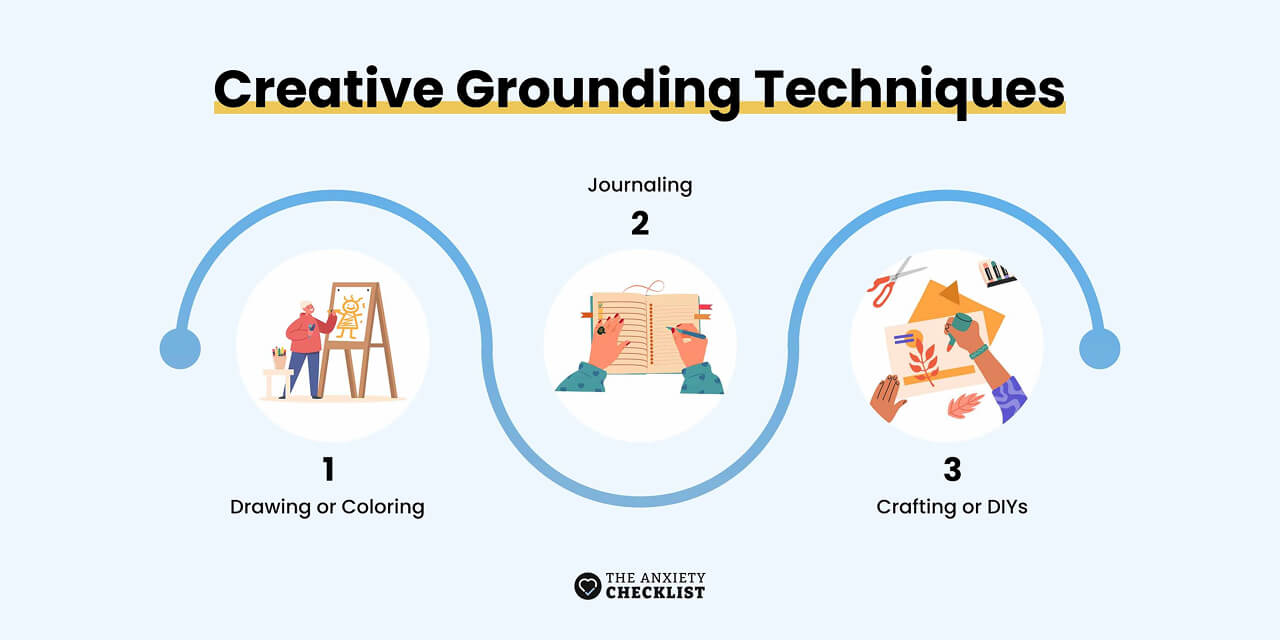
15. Drawing or Coloring
Drawing or coloring gives your mind something creative to focus on. These grounding techniques use movement, attention, and color to shift your thoughts from stress to calm. You don’t need to be an artist—just grab a pen or crayon and start. Let your hand move freely as you fill the page.
Notice the colors you choose and how they make you feel. This sensory and visual input is what makes art-based grounding techniques so effective.
Coloring books are popular because they're a structured way for emotional expression for children and adults. Try setting a timer for 10–15 minutes to make it part of your routine. You might also pair it with music or deep breathing for added calm.
16. Journaling
As a grounding technique, journaling gives your thoughts a place to land. When your thoughts feel tangled, writing them down helps you sort them out.
First, grab a notebook or digital journal and write whatever comes to mind. It doesn’t have to follow a format or make perfect sense. Just allow yourself to be honest.
You can try specific prompts to guide you. For example, “What do I feel right now?” or “What do I need now?” These questions help you check in with yourself. As you answer, you're grounding your emotions with words. Over time, this will help you become more aware of patterns, triggers, and strengths.
Another helpful method is stream-of-consciousness writing. Set a timer for 5 to 10 minutes and write without stopping. Don’t worry about spelling or grammar. Just let your thoughts flow. Journaling, like other grounding techniques, is most effective when done regularly.
17. Crafting or DIYs
Crafting is a deeply immersive way to ground yourself in the moment. Working with your hands—whether it’s knitting, sculpting clay, building a model, or making jewelry—gives your mind a break from racing thoughts.
Choose a craft that feels enjoyable and not overly complicated. Let it be about the process rather than the result.
Like other grounding techniques, crafting creates a flow state that helps you reconnect with your body and the present. You might even set a cozy atmosphere, like lighting a candle or playing calming music while you work.
Frequently Asked Questions
Final Thoughts
Previous Article
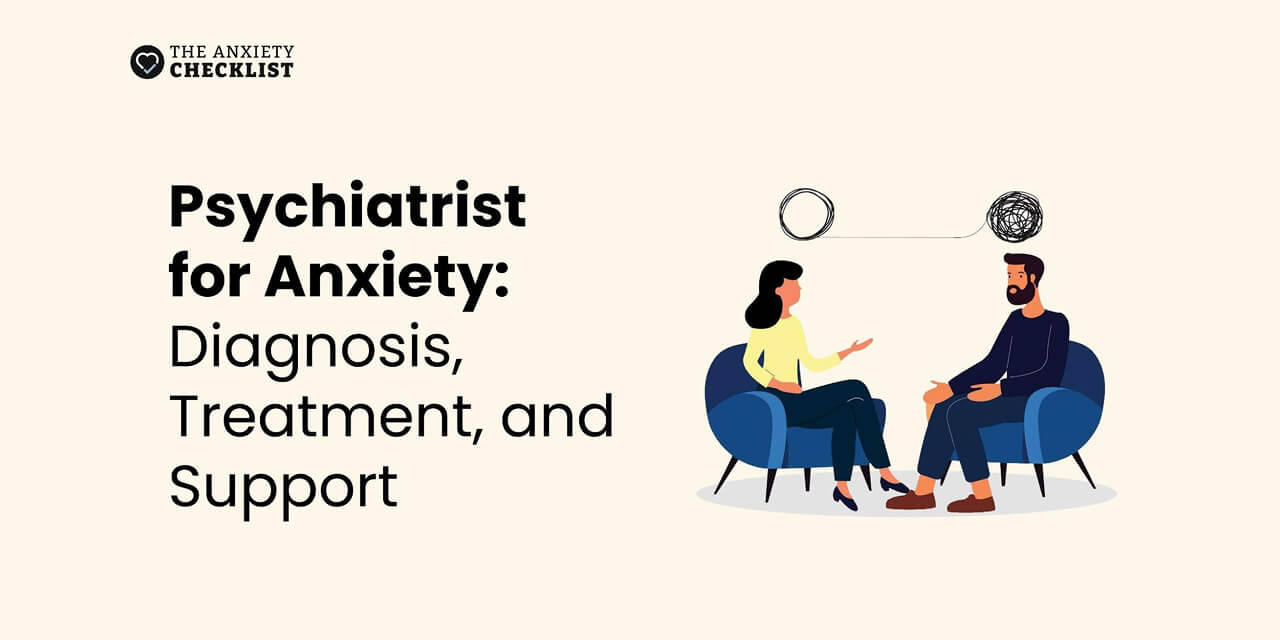
Psychiatrist for Anxiety: Diagnosis, Treatment, and Support

Advertisement
BetterHelp
BetterHelp makes starting therapy easy. Get a tailored therapist match based on your needs and preferences - in as little as 24 hours!
Enjoy 20% off your first month with code "anxietycheck"

4 million+ Helped
Access Therapy 24/7
Preferred by 94% of users
If you are in a crisis or any other person may be in danger - don't use this site. These resources can provide you with immediate help.


